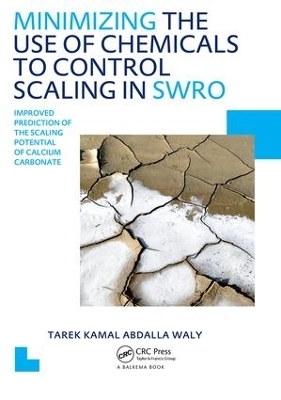
Minimizing the Use of Chemicals to Control Scaling in Sea Water Reverse Osmosis: Improved Prediction of the Scaling Potential of Calcium Carbonate
CRC Press (Verlag)
978-0-415-61578-5 (ISBN)
A comprehensive and detailed study on the scaling potential of calcium carbonate in seawater reverse osmosis systems (SWRO), this book provides a new approach for calculating the degree of supersaturation and the pH of the SWRO systems concentrates with the assistance of the feed-water pH and the inorganic carbon constituents. Furthermore, the book highlights the weakness in the present supersaturation indices and membrane manufacturers programs. Finally, the research suggested that SWRO concentrate is much lower undersaturated with respect to calcium carbonate than previously thought. This was confirmed by comprehensive pilot testing where acids and antiscalants used to prevent calcium carbonate scaling were completely eliminated from the pilot plant.
Dr Tarek Waly has 13 years experience in management, consultancy, sales, marketing and research in the water and wastewater treatment field. He is currently a lead R&D engineer at DOW Chemicals. He obtained his MSc from the UNESCO-IHE Institute for Water Education in Delft, and his Doctorate degree from the Delft University of Technology in Delft, The Netherlands.
Chapter 11.1 Background
1.2 Problem definition
1.3 The Overall Aim of the research
1.4 Research objectives
1.5 References
Chapter 2 2.1 Abstract
2.2 Background
Introduction
Induction time
Measurement tools
Effect of exchange CO2 on induction time
2.3 Materials
Inductively coupled plasma
Conductivity meter
pH meter
Reactors
Synthetic seawater concentrate preparation
2.4 Methods
Measurement of calcium with ICP
Salinity and accuracy of direct measurement of calcium in solution
Measurement of calcium carbonate retained on membrane filters
Effect of salinity, stability and accuracy of conductivity and pH measurment
Effect of mixing on the induction time
2.5 Results
Effect of salinity on the ICP measurements and accuracy
Accuracy of measurement of calcium carbonate retained on membrane filters
The effect of salinity on the conductivity and the pH measurments
The effect of carbon dioxide exchange in an open system
2.6 Conclusions
2.7 List of Symbols
2.8 References
Chapter 3 3.1 Abstract
3.2 Background
3.3 Materials
Synthetic seawater concentrate preparation
3.4 Methods
The effect of particles in synthetic seawater on the induction time
The effect of particle addition
Mixing effect
3.5 Results and discussion
The effect of particles in synthetic seawater on the induction time
The effect of particle addition
The effect of mixing speed on the induction time
The nucleation mechanism
3.6 Conclusions
3.7 List of symbols
3.8 References
Chapter 4 4.1 Abstract
4.2 Background
Introduction
Solubility of salts
Common methods used to determine the precipitation potential of CaCO3:
Stiff & Davis Stability Index (S&DSI)
Saturation Index (SI)
Saturation Ratio (Sa)
Mechanism of nucleation
Homogenous nucleation
Heterogeneous nucleation in a solution
Induction time
CaCO3 phases
The formation of hydrated CaCO3 forms
4.3 Materials
pH meter
Reactors
Synthetic seawater concentrate preparation
4.4 Methods
Induction time measurements
Solutions concentrations
Calculation of SI using PhreeqC
4.5 Results
The solubility product used by the S&DSI
Homogenous and heterogeneous nucleation
4.6 Conclusions
4.7 List of symbols
4.8 References
Chapter 5 5.1 Abstract
5.2 Introduction
5.3 Background
Saturation indices
Calculation of pH in SWRO concentrates
Effect of salinity on dissociation constants
Effect of salinity on the ion activity
5.4 Materials and Methods
Pilot plant
Concentrate pH in SWRO systems
5.5 Results and Discussion
pH calculations using equilibrium equations
pH calculations using manufacturers software
pH prediction using Phreeqc evaporation model
Field seawater concentrate measurements
5.6 Conclusions
5.6 List of Symbols
5.7 References
Chapter 66.1 Abstract
6.2 Background
Introduction
Calcium carbonate phases
The role of inorganic ions
Solubility of salts
Common methods used to determine the precipitation potential of CaCO3:
Saturation indices (SI and Sa)
Mechanism of nucleation
Induction time
6.3 Materials
pH meter
Reactors
Synthetic seawater concentrate preparation
6.4 Methods
Induction time measurements
Determination of co-precipitation
Determination of the final crystal phase of calcium carbonate
6.5 Results and discussion
Chapter 7
7.1 Conclusions
7.2 Recommendations for future work
| Reihe/Serie | IHE Delft PhD Thesis Series |
|---|---|
| Verlagsort | London |
| Sprache | englisch |
| Maße | 174 x 246 mm |
| Gewicht | 249 g |
| Themenwelt | Naturwissenschaften ► Biologie ► Evolution |
| Technik ► Umwelttechnik / Biotechnologie | |
| Weitere Fachgebiete ► Land- / Forstwirtschaft / Fischerei | |
| ISBN-10 | 0-415-61578-X / 041561578X |
| ISBN-13 | 978-0-415-61578-5 / 9780415615785 |
| Zustand | Neuware |
| Haben Sie eine Frage zum Produkt? |
aus dem Bereich


